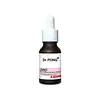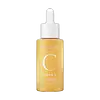What's inside
What's inside
 Key Ingredients
Key Ingredients

 Benefits
Benefits

 Concerns
Concerns

 Ingredients Side-by-side
Ingredients Side-by-side

Water
Skin ConditioningBiosaccharide Gum-1
HumectantHydroxyethylcellulose
Emulsion StabilisingHydroxypropyl Guar
Emulsion StabilisingNiacinamide
SmoothingHydroxyethyl Urea
HumectantGlycerin
HumectantGluconobacter/Honey Ferment Filtrate
Skin ConditioningSaccharide Isomerate
HumectantGlycine Soja Seed Extract
Skin ConditioningButylene Glycol
HumectantSilanediol Salicylate
EmollientGluconolactone
Skin ConditioningPotassium Azeloyl Diglycinate
Skin ConditioningCapryloyl Salicylic Acid
ExfoliatingSophora Angustifolia Root Extract
Skin ConditioningArbutin
AntioxidantAcetyl Tyrosine
Skin ConditioningSaxifraga Sarmentosa Extract
Skin ConditioningPaeonia Suffruticosa Root Extract
Skin ProtectingAminopropyl Ascorbyl Phosphate
AntioxidantScutellaria Baicalensis Root Extract
AstringentGlutathione
Allantoin
Skin ConditioningSodium Hyaluronate
HumectantLinolenic Acid
CleansingXanthan Gum
EmulsifyingPolyvinyl Alcohol
Glycolic Acid
BufferingLactic Acid
BufferingSodium Ascorbyl Phosphate
AntioxidantPalmitoyl Sh-Tripeptide-5 Norisoleucyl Sh-Nonapeptide-1
Skin ConditioningSodium Polyacrylate
AbsorbentEthylhexyl Stearate
EmollientTrideceth-6
EmulsifyingPolyacrylate Crosspolymer-6
Emulsion StabilisingHydroxyacetophenone
AntioxidantCaprylyl Glycol
EmollientDipropylene Glycol
HumectantDipotassium Glycyrrhizate
HumectantWater, Biosaccharide Gum-1, Hydroxyethylcellulose, Hydroxypropyl Guar, Niacinamide, Hydroxyethyl Urea, Glycerin, Gluconobacter/Honey Ferment Filtrate, Saccharide Isomerate, Glycine Soja Seed Extract, Butylene Glycol, Silanediol Salicylate, Gluconolactone, Potassium Azeloyl Diglycinate, Capryloyl Salicylic Acid, Sophora Angustifolia Root Extract, Arbutin, Acetyl Tyrosine, Saxifraga Sarmentosa Extract, Paeonia Suffruticosa Root Extract, Aminopropyl Ascorbyl Phosphate, Scutellaria Baicalensis Root Extract, Glutathione, Allantoin, Sodium Hyaluronate, Linolenic Acid, Xanthan Gum, Polyvinyl Alcohol, Glycolic Acid, Lactic Acid, Sodium Ascorbyl Phosphate, Palmitoyl Sh-Tripeptide-5 Norisoleucyl Sh-Nonapeptide-1, Sodium Polyacrylate, Ethylhexyl Stearate, Trideceth-6, Polyacrylate Crosspolymer-6, Hydroxyacetophenone, Caprylyl Glycol, Dipropylene Glycol, Dipotassium Glycyrrhizate
Water
Skin ConditioningNiacinamide
SmoothingDipropylene Glycol
Humectant1,2-Hexanediol
Skin ConditioningPropanediol
SolventSaccharomyces/Hippophae Rhamnoides Fruit Ferment Filtrate
Skin ConditioningNeopentyl Glycol Dicaprate
EmollientMethyl Gluceth-20
HumectantMethyl Trimethicone
Skin ConditioningPentylene Glycol
Skin ConditioningC12-14 Alketh-12
EmulsifyingPanthenol
Skin ConditioningPolyacrylate Crosspolymer-6
Emulsion StabilisingGlycerin
HumectantMethylpropanediol
SolventTranexamic Acid
AstringentHydroxyethylcellulose
Emulsion StabilisingAllantoin
Skin ConditioningXanthan Gum
EmulsifyingHydrogenated Lecithin
EmulsifyingSodium Polyacryloyldimethyl Taurate
Emulsion StabilisingAlpha-Arbutin
AntioxidantEthylhexylglycerin
Skin ConditioningButylene Glycol
HumectantParfum
MaskingGlycolic Acid
BufferingT-Butyl Alcohol
PerfumingCaprylyl Glycol
EmollientSodium Ascorbyl Phosphate
AntioxidantAscorbic Acid
AntioxidantAscorbyl Glucoside
AntioxidantDisodium Phosphate
BufferingPolysorbate 60
EmulsifyingSodium Phosphate
BufferingTocopherol
AntioxidantHippophae Rhamnoides Oil
EmollientWater, Niacinamide, Dipropylene Glycol, 1,2-Hexanediol, Propanediol, Saccharomyces/Hippophae Rhamnoides Fruit Ferment Filtrate, Neopentyl Glycol Dicaprate, Methyl Gluceth-20, Methyl Trimethicone, Pentylene Glycol, C12-14 Alketh-12, Panthenol, Polyacrylate Crosspolymer-6, Glycerin, Methylpropanediol, Tranexamic Acid, Hydroxyethylcellulose, Allantoin, Xanthan Gum, Hydrogenated Lecithin, Sodium Polyacryloyldimethyl Taurate, Alpha-Arbutin, Ethylhexylglycerin, Butylene Glycol, Parfum, Glycolic Acid, T-Butyl Alcohol, Caprylyl Glycol, Sodium Ascorbyl Phosphate, Ascorbic Acid, Ascorbyl Glucoside, Disodium Phosphate, Polysorbate 60, Sodium Phosphate, Tocopherol, Hippophae Rhamnoides Oil
Ingredients Explained
These ingredients are found in both products.
Ingredients higher up in an ingredient list are typically present in a larger amount.
Allantoin is a soothing ingredient known for its protective and moisturizingg properties. Because of this, it is often added to products with strong active ingredients.
Studies show higher concentrations of this ingredient can promote wound healing.
Though it can be derived from the comfrey plant, allantoin is produced synthetically for cosmetic products to ensure purity.
Learn more about AllantoinButylene Glycol (or BG) is used within cosmetic products for a few different reasons:
Overall, Butylene Glycol is a safe and well-rounded ingredient that works well with other ingredients.
Though this ingredient works well with most skin types, some people with sensitive skin may experience a reaction such as allergic rashes, closed comedones, or itchiness.
Learn more about Butylene GlycolCaprylyl Glycol is a humectant and emollient, meaning it attracts and preserves moisture.
It is a common ingredient in many products, especially those designed to hydrate skin. The primary benefits are retaining moisture, skin softening, and promoting a healthy skin barrier.
Though Caprylyl Glycol is an alcohol derived from fatty acids, it is not the kind that can dry out skin.
This ingredient is also used as a preservative to extend the life of products. It has slight antimicrobial properties.
Learn more about Caprylyl GlycolDipropylene Glycol is a synthetically created humectant, stabilizer, and solvent.
This ingredient helps:
Dipropylene glycol is technically an alcohol, but it belongs to the glycol family (often considered part of the ‘good’ alcohols). This means it is hydrating and gentle on skin unlike drying solvent alcohols like denatured alcohol.
As a masking agent, Dipropylene Glycol can be used to cover the smell of other ingredients. However, it does not have a scent.
Studies show Dipropylene Glycol is considered safe to use in skincare.
Learn more about Dipropylene GlycolGlycerin is already naturally found in your skin. It helps moisturize and protect your skin.
A study from 2016 found glycerin to be more effective as a humectant than AHAs and hyaluronic acid.
As a humectant, it helps the skin stay hydrated by pulling moisture to your skin. The low molecular weight of glycerin allows it to pull moisture into the deeper layers of your skin.
Hydrated skin improves your skin barrier; Your skin barrier helps protect against irritants and bacteria.
Glycerin has also been found to have antimicrobial and antiviral properties. Due to these properties, glycerin is often used in wound and burn treatments.
In cosmetics, glycerin is usually derived from plants such as soybean or palm. However, it can also be sourced from animals, such as tallow or animal fat.
This ingredient is organic, colorless, odorless, and non-toxic.
Glycerin is the name for this ingredient in American English. British English uses Glycerol/Glycerine.
Learn more about GlycerinGlycolic Acid is arguably the most famous alpha hydroxy acid (AHA) with tons of research backing its benefits.
It is found naturally in sugar cane but the form used in skincare is usually synthetic for purity and stability.
Glycolic acid removes the top layer of dead skin cells to allow newer and fresher ones to emerge.
AHAs work by breaking down the structural “glue” that holds old skin cells in place. When that buildup is gone, your skin can renew itself more efficiently.
Research also shows glycolic acid stimulates collagen production, helping to firm and thicken the skin over time. This is one of its biggest advantages over other AHAs.
Overall, glycolic acid helps with:
Fun fact: Glycolic acid boosts skin hydration by helping it produce molecules that increase hyaluronic acid naturally.
To work best, glycolic acid products should have a pH between 3-4 (that’s where exfoliation is most effective but still gentle on skin).
The pH and concentration of a product are key to its effectiveness:
It is normal to feel a slight stinging sensation when using glycolic acid. This usually fades as your skin adjusts.
Because glycolic acid has the smallest molecular size in the AHA family, it can penetrate deeper, which enhances its effectiveness but also makes it more likely to irritate sensitive skin.
If your skin is very sensitive or prone to rosacea, glycolic acid may be too strong; in that case, try milder options like lactic acid or a PHA instead.
Recent studies suggest glycolic acid might even help protect against UV damage. But don’t skip sunscreen! Freshly exfoliated skin is more sensitive to the sun.
Glycolic acid is a skincare superstar. It smooths, brightens, hydrates, and firms the skin. Unless you’re highly sensitive, it’s well worth adding to your routine.
Read more about some other popular AHA's here:
Learn more about Glycolic AcidHydroxyethylcellulose is used to improve the texture of products. It is created from a chemical reaction involving ethylene oxide and alkali-cellulose. Cellulose is a sugar found in plant cell walls and help give plants structure.
This ingredient helps stabilize products by preventing ingredients from separating. It can also help thicken the texture of a product.
This ingredient can also be found in pill medicines to help our bodies digest other ingredients.
Learn more about HydroxyethylcelluloseNiacinamide is a multitasking form of vitamin B3 that strengthens the skin barrier, reduces pores and dark spots, regulates oil, and improves signs of aging.
And the best part? It's gentle and well-tolerated by most skin types, including sensitive and reactive skin.
You might have heard of "niacin flush", or the reddening of skin that causes itchiness. Niacinamide has not been found to cause this.
In very rare cases, some individuals may not be able to tolerate niacinamide at all or experience an allergic reaction to it.
If you are experiencing flaking, irritation, and dryness with this ingredient, be sure to double check all your products as this ingredient can be found in all categories of skincare.
When incorporating niacinamide into your routine, look out for concentration amounts. Typically, 5% niacinamide provides benefits such as fading dark spots. However, if you have sensitive skin, it is better to begin with a smaller concentration.
When you apply niacinamide to your skin, your body converts it into nicotinamide adenine dinucleotide (NAD). NAD is an essential coenzyme that is already found in your cells as "fuel" and powers countless biological processes.
In your skin, NAD helps repair cell damage, produce new healthy cells, support collagen production, strengthen the skin barrier, and fight environmental stressors (like UV and pollution).
Our natural NAD levels start to decline with age, leading to slower skin repair, visible aging, and a weaker skin barrier. By providing your skin niacinamide, you're recharging your skin's NAD levels. This leads to stronger, healthier, and younger looking skin.
Another name for vitamin B3 is nicotinamide. This vitamin is water-soluble and our bodies don't store it. We obtain Vitamin B3 from either food or skincare. Meat, fish, wheat, yeast, and leafy greens contain vitamin B3.
The type of niacinamide used in skincare is synthetically created.
Learn more about NiacinamidePolyacrylate Crosspolymer-6 is a texture enhancer and pH adjuster.
It is be used to thicken water-based products and create a gel-texture with a velvet feel.
One manufacturer claims this ingredient to have a pH range of 2-8 and to be biodegradable.
Learn more about Polyacrylate Crosspolymer-6Sodium Ascorbyl Phosphate is a form of Vitamin C. It is the salt of ascorbic acid.
This ingredient is more gentle than ascorbic acid. It is also more stable when exposed to light and oxygen.
Vitamin C helps reduce redness, improve skin texture, reduce the effects of aging, reduce the visibility of dark spots, and brighten skin.
Your skin uses Vitamin C to produce collagen and collagen production plays a role in having a strong skin barrier and plump skin. As an antioxidant, this ingredient also helps reduce the signs of aging such as fine-lines and wrinkles.
VItamin C helps brighten skin by blocking the process of skin darkening.
In a 2011 study, Sodium Ascorbyl Phosphate was found to have antibacterial properties. This may help treat acne.
Read more about other types of Vitamin C:
Learn more about Sodium Ascorbyl PhosphateWater. It's the most common cosmetic ingredient of all. You'll usually see it at the top of ingredient lists, meaning that it makes up the largest part of the product.
So why is it so popular? Water most often acts as a solvent - this means that it helps dissolve other ingredients into the formulation.
You'll also recognize water as that liquid we all need to stay alive. If you see this, drink a glass of water. Stay hydrated!
Learn more about WaterXanthan gum is used as a stabilizer and thickener within cosmetic products. It helps give products a sticky, thick feeling - preventing them from being too runny.
On the technical side of things, xanthan gum is a polysaccharide - a combination consisting of multiple sugar molecules bonded together.
Xanthan gum is a pretty common and great ingredient. It is a natural, non-toxic, non-irritating ingredient that is also commonly used in food products.
Learn more about Xanthan Gum